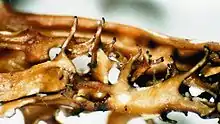| Cetrariella | |
|---|---|
 | |
| Cetrariella delisei | |
| Scientific classification | |
| Domain: | Eukaryota |
| Kingdom: | Fungi |
| Division: | Ascomycota |
| Class: | Lecanoromycetes |
| Order: | Lecanorales |
| Family: | Parmeliaceae |
| Genus: | Cetrariella Kärnefelt & A.Thell (1993) |
| Type species | |
| Cetrariella delisei | |
| Species | |
|
C. delisei | |
Cetrariella is a genus of foliose lichens in the family Parmeliaceae. It contains three species.
Taxonomy
The genus was circumscribed in 1993 by lichenologists Ingvar Kärnefelt and Arne Thell, with Cetrariella delisei assigned as the type species. Cetrariella was created as a segregate of genus Cetraria, since previous studies on ascus structure demonstrated that some species placed in Cetraria did not belong there.[1]
In 2017, Divakar and colleagues used a recently developed "temporal phylogenetic" approach to identify temporal bands for specific taxonomic ranks in the family Parmeliaceae, suggesting that groups of species that diverged within the time window of 29.45–32.55 million years ago represent genera. They proposed to synonymize Cetrariella with Cetraria, along with several other Parmelioid genera, so that all the genera within the Parmeliaceae are about the same age.[2] Although some of their proposed taxonomic changes were accepted, the synonymization of Cetrariella with Cetraria was not accepted in a later critical analysis of the temporal banding technique for lichen classification.[3]
Description
Cetrariella species grow on the ground (terricolous) and on rocks (saxicolous). They have an upper and lower cortex, both of which are single-layered and measure 15–40 μm. Their ascus is broadly club-shaped (clavate), with dimensions of about 40 by 15 μm, while the ascospores are ellipsoidal, measuring 5–10 by 2.5–5 μm. Secondary compounds present include gyrophoric acid and hiascic acid.[1]
Species
- Cetrariella delisei (Bory ex Schaer.) Kärnefelt & A.Thell 1993)
- Cetrariella fastigiata (Delise ex Nyl.) Kärnefelt & A.Thell 1993)
- Cetrariella sorediella (Lettau) V.J.Rico & A.Thell (2011)[4]
Cetrariella commixta, a lichen transferred to Cetrariella in 2004,[5] is now a member of Melanelia.[6]
References
- 1 2 Kärnefelt, Ingvar; Mattsson, Jan-Eric; Thell, Arne; Karnefelt, Ingvar (1993). "The lichen genera Arctocetraria, Cetraria, and Cetrariella (Parmeliaceae) and their presumed evolutionary affinities". The Bryologist. 96 (3): 394–404. doi:10.2307/3243869. JSTOR 3243869.
- ↑ Divakar, Pradeep K.; Crespo, Ana; Kraichak, Ekaphan; Leavitt, Steven D.; Singh, Garima; Schmitt, Imke; Lumbsch, H. Thorsten (2017). "Using a temporal phylogenetic method to harmonize family- and genus-level classification in the largest clade of lichen-forming fungi". Fungal Diversity. 84: 101–117. doi:10.1007/s13225-017-0379-z. S2CID 40674310.
- ↑ Lücking, Robert (2019). "Stop the abuse of time! Strict temporal banding is not the future of rank-based classifications in fungi (including lichens) and other organisms". Critical Reviews in Plant Sciences. 38 (3): 199–253. doi:10.1080/07352689.2019.1650517. S2CID 202859785.
- ↑ Nelsen, Matthew P.; Chavez, Natali; Sackett-Hermann, Erin; Thell, Arne; Randlane, Tiina; Divakar, Pradeep K.; Rico, Víctor J.; Lumbsch, H. Thorsten (2011). "The cetrarioid core group revisited (Lecanorales: Parmeliaceae)". The Lichenologist. 43 (6): 537–551. doi:10.1017/S0024282911000508. S2CID 86200001.
- ↑ Thell, Arne; Feuerer, Tassilo; Kärnefelt, Ingvar; Myllys, Leena; Stenroos, Soili (2004). "Monophyletic groups within the Parmeliaceae identified by ITS rDNA, β-tubulin and GAPDH sequences". Mycological Progress. 3 (4): 297–314. doi:10.1007/s11557-006-0100-1. S2CID 39393303.
- ↑ "Record details: Cetrariella commixta (Nyl.) A. Thell & Kärnefelt, in Thell, Feuerer, Kärnefelt, Myllys & Stenroos, Mycol. Progr. 3(4): 309 (2004)". Index Fungorum. Retrieved 25 May 2021.